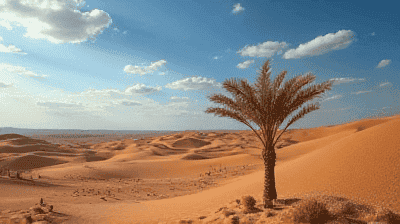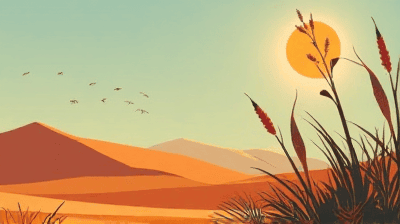
When we think of biodiversity, lush rainforests and vibrant coral reefs often come to mind. However, deserts, traditionally viewed as barren wastelands, are increasingly recognized for their rich and diverse ecosystems. These arid landscapes host extraordinary adaptations and a surprising variety of life forms that are uniquely suited to thrive in harsh conditions. As climate change and human activity continue to threaten ecosystems worldwide, it is crucial to understand the surging biodiversity of deserts and the imperative to protect it.
Deserts cover approximately one-third of the Earth's land surface and are categorized into several types, including:
Hot Deserts: Characterized by high temperatures and low precipitation, these deserts, such as the Sahara and the Sonoran Desert, showcase extraordinary adaptations in plant and animal life.
Cold Deserts: Places like the Gobi and the Great Basin receive less sunlight and have colder temperatures, yet they also boast unique biodiversity.
Coastal Deserts: These deserts, like the Namib, are influenced by ocean currents, leading to a climate that supports specialized life forms.
Desert ecosystems are not devoid of life; rather, they are teeming with unique species, many of which exhibit remarkable adaptations to survive in extreme conditions.
Desert biodiversity encompasses an array of life forms, including:
Flora: Many desert plants have evolved specific adaptations, such as water storage tissues, deep root systems, and spines instead of leaves to minimize water loss. Common examples include cacti, succulents, and drought-resistant shrubs.
Fauna: Animals in the desert have developed diverse strategies to cope with the lack of moisture. Many are nocturnal, staying hidden from the sun during the day to avoid heat stress. Creatures like the fennec fox, desert tortoise, and various rodents showcase unique physiological and behavioral adaptations.
Microbial Diversity: Desert soils harbor an astonishing array of microorganisms that play essential roles in nutrient cycling and soil health. These microbes are adept at thriving in extreme conditions, contributing to the overall ecosystem's resilience.

Desert biodiversity is not just fascinating; it provides essential ecosystem services that benefit both the environment and human populations. Key services include:
Soil Formation and Health: Desert organisms contribute to soil processes, enhancing soil fertility and supporting plant growth.
Carbon Sequestration: The unique structures of desert plants enable them to sequester carbon dioxide, helping to mitigate climate change.
Water Regulation: Desert ecosystems play a critical role in regulating water cycles, influencing runoff and aquifer recharge.
Supporting Local Communities: Indigenous and local communities depend on desert biodiversity for their livelihoods, using native plants for food, medicine, and materials.
Studying desert biodiversity can lead to valuable scientific insights. For example, understanding how organisms adapt to extreme environments can inspire innovations in fields such as medicine, agriculture, and environmental science. Furthermore, the resilience of desert ecosystems can provide paradigms for conservation strategies in other biomes facing similar pressures.
Desert plants exhibit various adaptations to conserve water and endure extreme temperatures:
Water Storage: Many desert plants, such as cacti, possess specialized tissues that store water for use during dry periods.
Reduced Leaf Surface Area: Spines or reduced leaves minimize the surface area for transpiration, helping to conserve water.
Deep Root Systems: Some plants develop extensive root systems that penetrate deep into the soil to access groundwater.
Desert animals demonstrate remarkable adaptations that allow them to thrive in harsh conditions:
Nocturnal Behavior: Many desert animals are nocturnal, avoiding daytime heat and seeking shelter in burrows or shade.
Physiological Adaptations: Some species have evolved the ability to tolerate high levels of dehydration. For example, the kangaroo rat can survive without drinking water, obtaining it from the seeds it consumes.
Camouflage and Defense: Many desert creatures have coloration that blends with their environment, providing protection from predators.
Microorganisms in desert soils have evolved unique traits to withstand extreme conditions:
Drought Resistance: Desert microbes can enter dormant states during dry periods, resuming activity when moisture becomes available.
Nutrient Cycling: Microbes play a critical role in decomposing organic matter and recycling nutrients, facilitating plant growth.

Climate change poses a significant threat to desert ecosystems. Rising temperatures, altered precipitation patterns, and increased frequency of extreme weather events can disrupt established ecological balances. Species that have adapted to specific climate conditions may struggle to survive, leading to declines in biodiversity.
Rapid urbanization and land conversion for agriculture can lead to habitat loss and fragmentation. Deserts, often seen as marginal lands, are increasingly targeted for development, which can disrupt delicate ecosystems and threaten the species that rely on them.
The introduction of invasive species can have devastating effects on native deserts. Non-native plants and animals may outcompete local species for resources, disrupting food webs and leading to declines in biodiversity. Invasive species can also alter soil dynamics and water availability, further exacerbating the challenges faced by native organisms.
Unsustainable practices such as overgrazing, mining, and water extraction can severely degrade desert ecosystems. Overgrazing by livestock can lead to soil compaction and erosion, while mining operations can disrupt habitats and introduce pollutants.
Establishing protected areas is a crucial step in conserving desert ecosystems. National parks, reserves, and wildlife refuges can safeguard critical habitats and provide sanctuary for endangered species. Success stories, such as the establishment of the Saguaro National Park in the Sonoran Desert, illustrate the importance of protecting these unique landscapes.
Engaging local communities in conservation efforts is essential for achieving sustainable outcomes. Community-based conservation initiatives can empower local populations to manage their natural resources sustainably, fostering stewardship and generating economic benefits through ecotourism and sustainable harvesting practices.
Restoration efforts aimed at rehabilitating degraded habitats can significantly benefit desert biodiversity. Techniques such as reintroduction of native species, removal of invasive plants, and rehabilitation of soil can restore ecosystem health and enhance resilience.
Ongoing research and monitoring are crucial for understanding desert ecosystems and the challenges they face. Long-term studies can provide insights into ecological processes, helping to inform conservation strategies and adaptive management practices.

Increasing our understanding of the complex interactions within desert ecosystems is vital for effective conservation. Research that focuses on the relationships between species, their habitats, and environmental factors will inform management strategies that enhance resilience.
As climate change impacts intensify, developing climate adaptation strategies for desert ecosystems will be essential. These strategies may involve optimizing water use, enhancing soil health, and promoting species resilience to changing conditions.
Encouraging sustainable land management practices, such as regulated grazing, native plant landscaping, and minimal impact tourism, can help mitigate human impacts on desert ecosystems. Education and outreach efforts can raise awareness of the value of desert biodiversity and promote responsible usage.
Addressing the challenges facing desert biodiversity will require collaboration among governments, NGOs, scientists, and local communities. Partnerships that foster knowledge sharing, resource pooling, and innovative solutions will be key to effective conservation.
The surging biodiversity of deserts is a testament to the remarkable adaptability of life in the most challenging environments. As we confront the numerous threats facing desert ecosystems, it is imperative that we recognize the value of preserving this biodiversity not only for the plants and animals that inhabit these landscapes but also for the services they provide to humanity.
Investing in the conservation of desert biodiversity is crucial for maintaining ecological balance, supporting local communities, and mitigating the impacts of climate change. By prioritizing efforts to protect and restore these unique ecosystems, we can ensure that the wonders of desert life continue to thrive for generations to come.
As stewards of the planet, we have a responsibility to safeguard the diverse tapestry of life that exists in deserts. Through concerted efforts, we can protect these precious ecosystems and the invaluable biodiversity they support.